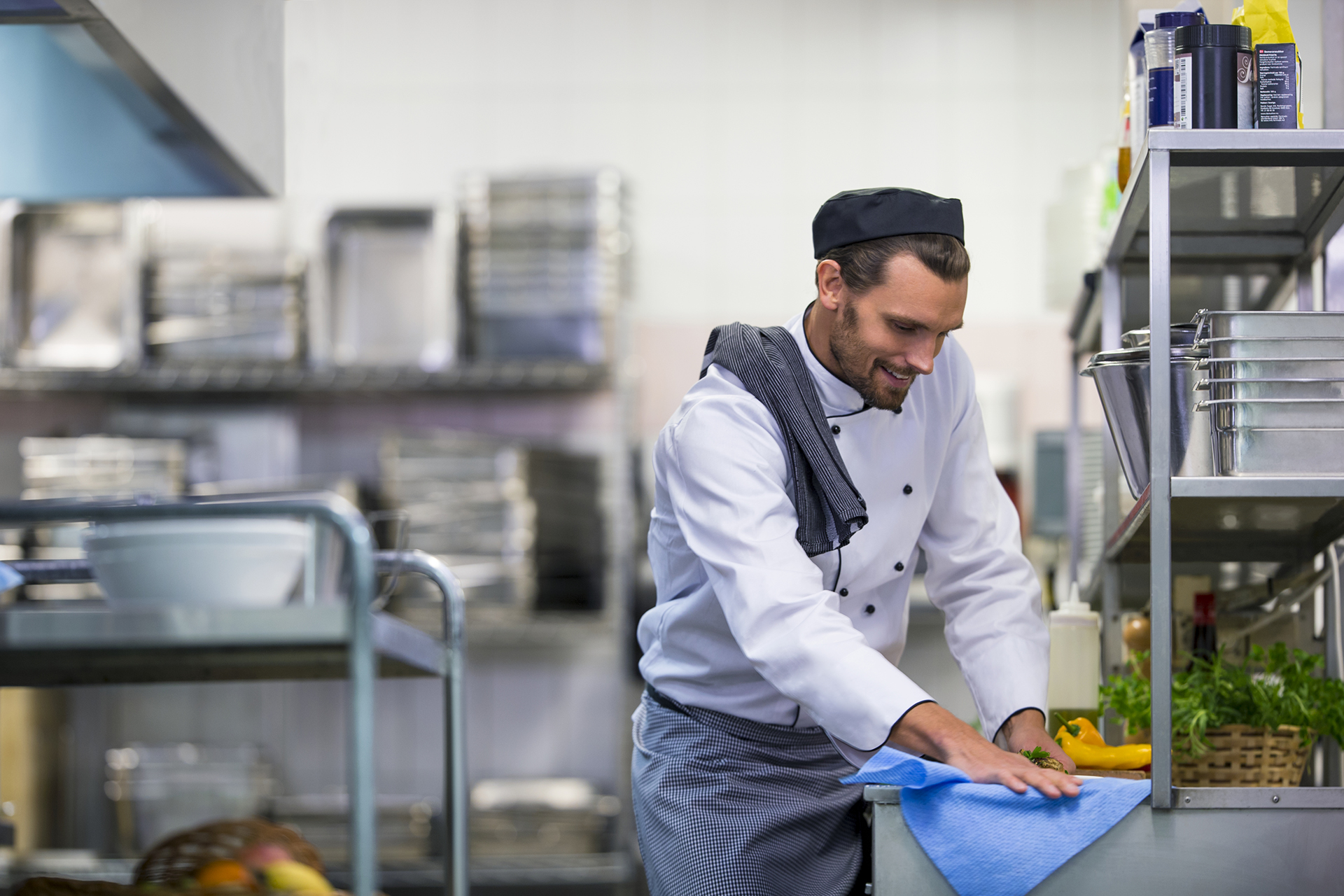Today, customer expectations for restaurant hygiene are increasingly high. According to the second instalment of The New Normal for Restaurants study1, sanitization standards are now top purchase criteria in the foodservice industry – having not ranked highly prior to the pandemic. In fact, customers tend to spend twice as much in restaurants that demonstrate high cleaning standards2.
When customers visit a restaurant, visible cleaning is now an unspoken requirement. Building customer confidence means demonstrating frequent surface cleaning of high traffic zones, pristine table hygiene and ensuring employees are seen engaging in hand washing and sanitization.
Cleanliness will always be a crucial factor in attracting new customers – and it’s vital for ensuring existing guests return to eat at your restaurant time and time again. With that in mind, we bring you seven simple but effective ways to optimize sanitation – both front and back of house.
1. Ensure your cleaning products are fit for purpose
When it comes to cleaning, sanitizing and disinfecting your restaurant, investing in high quality cleaning products will ensure each job gets done thoroughly. Remember, there is a difference between cleaning, sanitizing, and disinfecting3, which means they require bespoke products:
- Cleaning: Removing dirt from surfaces (with soap and water)
- Sanitizing: Reducing pathogens on surfaces (with anti-bacterial solution)
- Disinfecting: Removing all microorganisms from surfaces (with anti-viral solution)
2. Create surface cleaning schedule
To ensure a safe and hygienic eating environment, it’s important that restaurants keep up with surface cleaning high-touch surface cleaning. Front-of-house waiting staff should pay attention to menus, tables, chairs, countertops, door handles, light switches, dispensers, and credit card machines. Back-of-house kitchen staff should pay attention to door handles, light switches, dispensers, food contact surfaces, hand contact surfaces, sink faucets, handles, and utensils. With so many different zones to clean throughout the shift, it can be helpful to create a clear surface cleaning guide for both front-of-house and back-of-house employees to ensure no surface gets neglected.
3. Switch to a more effective napkin solution

Napkins are a key product that help customers keep themselves and their table free of mess and spills. However, refilling napkin dispensers and fulfilling guest requests for more napkins can be time-consuming for busy front-of-house staff. To help improve hygiene and efficiency at the same time, consider investing in new innovations that make cleaning up easier for customers. Tork Xpressnap Fit is a fully covered napkin dispenser that promotes better hygiene by protecting napkins from dirt and moisture. One-at-a-time dispensing means guests only use the number of napkins they need, which saves time spent on both cleaning and refilling.
4. Prioritize a hygienic restroom experience
Many customers will judge a restaurant by the quality and hygiene of the washroom facilities. A bad impression here can have a serious impact, so regular sanitizing of restrooms is paramount to the entire experience. As a rule, busy restaurants should disinfect toilets, mop restroom floors, clean hand wash basins and refill soap dispensers between 6-10 times every day, with regular deep cleans scheduled too. Consider installing high quality air fresheners in your restrooms to ensure customers are greeted with a pleasant aroma.
5. Engage in visible front-of-house cleaning
Once upon a time, it would have been very unusual for guests to see restaurant employees engaging in key cleaning duties, which would typically be done before and after shifts or during quiet periods. These days, important cleaning tasks that would usually take place behind the scenes are being brought to the forefront to enhance customer trust. 85% of guests actually want to see visible proof of strengthened sanitization procedures4 – it makes them feel reassured that hygiene is paramount. Employees should confidently engage in visible hand sanitization, wipe down surfaces such as tables and sweep up debris from the floor to enhance guest experience.
6. Increase kitchen sterilization measures

Kitchen staff are often incredibly busy, particularly at peak mealtimes, so implementing a few measures to help improve hygiene in the back of your restaurant can go a long way. Start by ensuring appropriate cleaning products and cloths are placed on every work station so staff can clean up spills as they go – preferably reachable with one hand. When the restaurant is calm and quiet, back-of-house staff should spend time cleaning and organizing the kitchen as required to prepare for further busy periods. To aid sanitization back of house in your restaurant, try to declutter and remove any unnecessary objects that prevent thorough cleaning.
7. Improve hand hygiene by optimizing dispenser placement
To improve overall hygiene in your restaurant, consider optimizing dispenser placement to prevent cross-contamination and reduce the spread of germs. Hand sanitizer dispensers should be set up for easy accessibility for both guests and employees. Touch-free hand sanitizer dispensers are a great idea because you have even more options for convenient placement, such as fixed to a wall for ease of use.
Sources
1 Simon Kucher: Restaurant Sanitization Standards
2 QSR Magazine: Restaurant visitation criteria
3 Medline Plus: Cleaning, sanitizing, disinfecting
4 Restaurant Business: Customer perception of value
